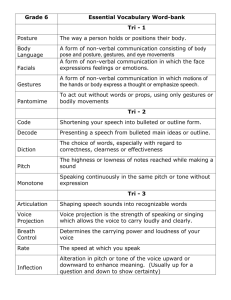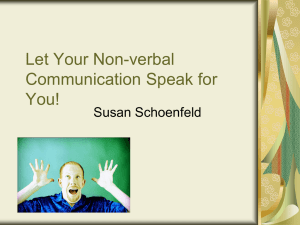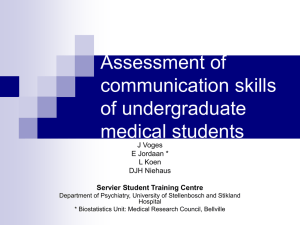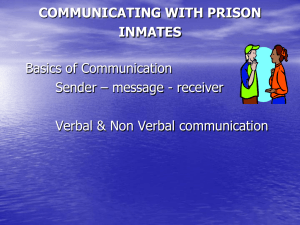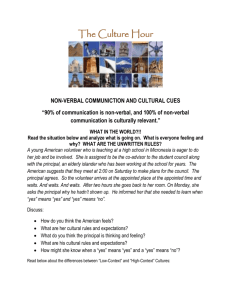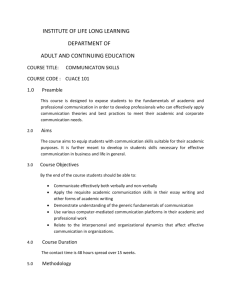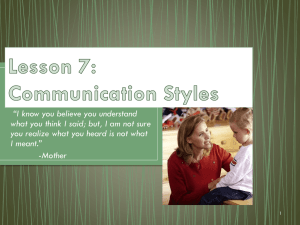Self Employed Support Worker Job Description
advertisement
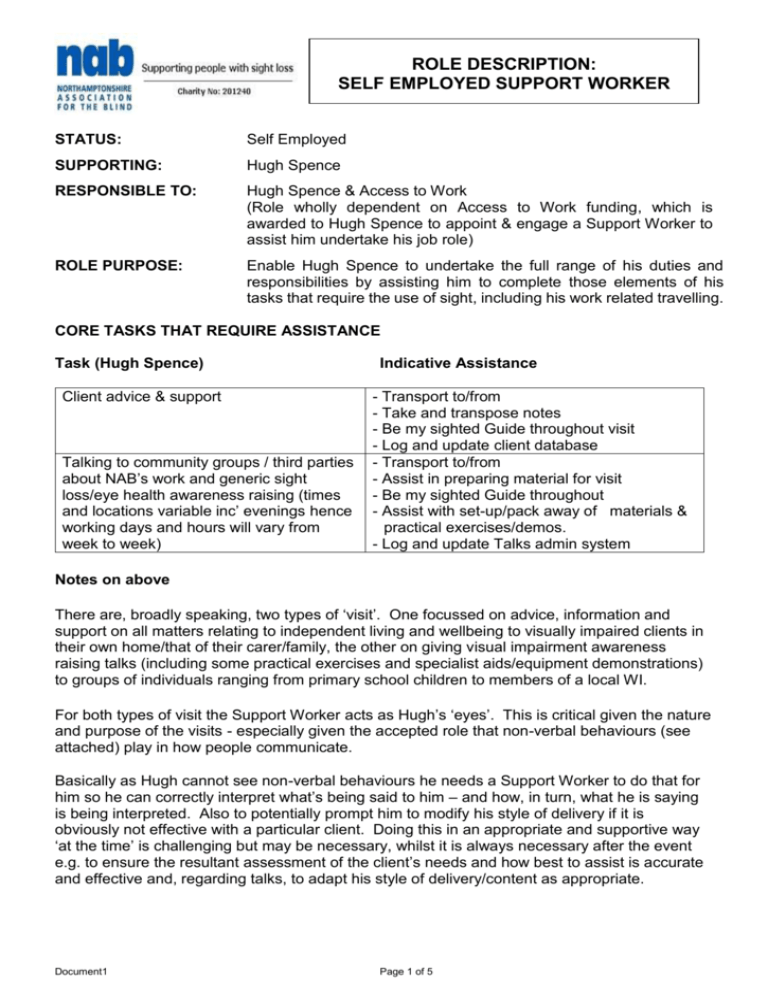
ROLE DESCRIPTION: SELF EMPLOYED SUPPORT WORKER STATUS: Self Employed SUPPORTING: Hugh Spence RESPONSIBLE TO: Hugh Spence & Access to Work (Role wholly dependent on Access to Work funding, which is awarded to Hugh Spence to appoint & engage a Support Worker to assist him undertake his job role) ROLE PURPOSE: Enable Hugh Spence to undertake the full range of his duties and responsibilities by assisting him to complete those elements of his tasks that require the use of sight, including his work related travelling. CORE TASKS THAT REQUIRE ASSISTANCE Task (Hugh Spence) Client advice & support Talking to community groups / third parties about NAB’s work and generic sight loss/eye health awareness raising (times and locations variable inc’ evenings hence working days and hours will vary from week to week) Indicative Assistance - Transport to/from - Take and transpose notes - Be my sighted Guide throughout visit - Log and update client database - Transport to/from - Assist in preparing material for visit - Be my sighted Guide throughout - Assist with set-up/pack away of materials & practical exercises/demos. - Log and update Talks admin system Notes on above There are, broadly speaking, two types of ‘visit’. One focussed on advice, information and support on all matters relating to independent living and wellbeing to visually impaired clients in their own home/that of their carer/family, the other on giving visual impairment awareness raising talks (including some practical exercises and specialist aids/equipment demonstrations) to groups of individuals ranging from primary school children to members of a local WI. For both types of visit the Support Worker acts as Hugh’s ‘eyes’. This is critical given the nature and purpose of the visits - especially given the accepted role that non-verbal behaviours (see attached) play in how people communicate. Basically as Hugh cannot see non-verbal behaviours he needs a Support Worker to do that for him so he can correctly interpret what’s being said to him – and how, in turn, what he is saying is being interpreted. Also to potentially prompt him to modify his style of delivery if it is obviously not effective with a particular client. Doing this in an appropriate and supportive way ‘at the time’ is challenging but may be necessary, whilst it is always necessary after the event e.g. to ensure the resultant assessment of the client’s needs and how best to assist is accurate and effective and, regarding talks, to adapt his style of delivery/content as appropriate. Document1 Page 1 of 5 Task (Hugh Spence) Run visually impaired client interest groups at the Northampton Sight Centre e.g. Computer Group Basic administrative tasks associated with my job. Client advice & support (office based) Indicative Assistance - Be my sighted Guide if and as necessary. - Assist me with group administration if and as necessary e.g. recording attendances. - Extract information from databases e.g. client telephone numbers so I can call a client. - Assist manage online calendar - Log and update client database Notes on above Support Worker role is not to do Hugh’s job, but to assist him by undertaking those aspects that require the use of sight e.g. whilst Hugh will always do client calls the Support Worker will have to access the client database to extract contact numbers and, afterwards, update the system with the outcome of the call as directed by Hugh. Need for office based assistance variable as volunteers may be available to provide the necessary assistance. General Note As self-employed (appointed by Hugh Spence) and funded by Access to Work you must comply with their requirements over submitting invoices for work done. Work related expenses e.g. mileage costs associated with transporting Hugh Spence to be claimed from NAB, payable on the basis on NAB’s expenses policy. Attached Non Verbal Behavior Guide (Document Produced 06.01.2015) Document1 Page 2 of 5 NON VERBAL BEHAVIOURS Interpersonal communication not only involves the explicit meaning of words, that is the information or message conveyed, but also refers to implicit messages, whether intentional or not, which may be expressed through non-verbal behaviours. Non-verbal communications include facial expressions, the tone and pitch of the voice, gestures displayed through body language (kinesics) and the physical distance between communicators (proxemics). These non-verbal signals can give clues and additional information and meaning over and above spoken (verbal) communication. A great deal of recent research indicates the importance of having your nonverbal behaviour consistent with your verbal behaviour. Employees who were surveyed expressed confusion by the mismatch between the verbal and nonverbal messages of their managers. They reported that when they were confronted with a mismatch between verbal and non-verbal messages, they almost always responded to the non-verbal portion of the message – the voice quality and the facial expression – rather than the words. Even a small child can learn to lie with words, but since their nonverbal behaviour is much harder for them to control, it almost always gives them away. This is why most of us tend to trust the nonverbal message much more than the verbal one when the two don’t match. Often called non-verbal communication (NVC), this forms 85% of our ‘message’. When somebody walks into a room, we immediately start reading their non-verbal signals – their physical appearance, posture and the clothes they are wearing (or not wearing!). Within 4 seconds we have started to make some assumptions about the kind of person they are and whether there is anything about them with which we can identify with. If there is, we are more likely to want to get to know them. If there isn’t, we probably won’t bother. Non-verbal messages allow individuals to: Reinforce or modify what is said in words. For example, people may nod their heads vigorously when saying “Yes” to emphasise that they agree with the other person, but a shrug of the shoulders and a sad expression when saying “I’m fine thanks,” may imply that things are not really fine at all! Convey information about their emotional state. Define or reinforce the relationship between people. Provide feedback to the other person Regulate the flow of communication, for example by signalling to others that they have finished speaking or wish to say something When we communicate, non-verbal cues can have as great as an impact on the listener as the spoken word There are many different aspects of non-verbal communication including: Body Movements (Kinesics) Body movements include gestures, posture, head and hand movements or whole body movements. Body movements can be used to reinforce or emphasise what a person is saying and also offer information about the emotions and attitudes of a person. However, it is also possible for body movements to conflict with what is said. A skilled observer may be able to detect such discrepancies in behaviour and use them as a clue to what someone is really feeling. Emblems: Gestures that serve the same function as a word are called emblems. For example, Document1 Page 3 of 5 NON VERBAL BEHAVIOURS the signals that mean ‘OK’, ‘Come here!’, or the hand movement used when hitch-hiking. However, be aware that whilst some emblems are internationally recognised, others may need to be interpreted in their cultural context. Illustrators: Gestures which accompany words to illustrate a verbal message are known as illustrators. For example, the common circular hand movement which accompanies the phrase ‘over and over again’, or nodding the head in a particular direction when saying ‘over there’. Affect Displays: These are facial expressions or gestures which show the emotions we feel. These are often unintentional and can conflict with what is being said. Such expressions give strong clues as to the true emotional state of a person. Regulators: Gestures used to give feedback when conversing are called regulators, for example head nods, short sounds such as ‘uh-huh’, ‘mm-mm’, and expressions of interest or boredom. Regulators allow the other person to adapt his or her speech to reflect the level of interest or agreement. Without receiving feedback, many people find it difficult to maintain a conversation. Adaptors: Non-verbal behaviours which either satisfy some physical need such as scratching or adjusting uncomfortable glasses, or represent a psychological need such as biting fingernails when nervous. Although normally subconscious, adaptors are more likely to be restrained in public places than in the private world of individuals where they are less likely to be noticed. Adaptive behaviours often accompany feelings of anxiety or hostility. Posture Posture can reflect people’s emotions, attitudes and intentions. Research has identified a wide range of postural signals and their meanings, such as: Open and Closed Posture: Two forms of posture have been identified, ‘open’ and ‘closed’, which may reflect an individual’s degree of confidence, status or receptivity to another person. Someone seated in a closed position might have his/her arms folded, legs crossed or be positioned at a slight angle from the person with whom they are interacting. In an open posture you might expect to see someone directly facing you with hands apart on the arms of the chair. An open posture can be used to communicate openness or interest in someone and a readiness to listen, whereas the closed posture might imply discomfort or disinterest. Mirroring: Notice the way a loving couple relate to each other. You might like to observe a close relationship in person or on television. You will see that the partners’ postures will match, as if one partner is a mirror reflection of the other. For example, if one partner drapes an arm over the back of a chair this might be replicated in the other person’s position. If one partner frowns, it could be reflected in the other partner’s facial expression. This ‘mirroring’ indicates interest and approval between people and serves to reassure others of interest in them and what they are saying. Eye Contact Eye contact is an important aspect of non-verbal behaviour. In interpersonal interaction, it serves three main purposes: To give and receive feedback: Looking at someone lets them know that the receiver is concentrating on the content of their speech. Not maintaining eye contact can indicate disinterest. Communication may not be a smooth process if a listener averts their eyes too frequently. To let a partner know when it is their ‘turn’ to speak: This is related to the above point. Eye contact is more likely to be continuous when someone is listening, rather than speaking. When a person has finished what they have to say, they will look directly at the other person Document1 Page 4 of 5 NON VERBAL BEHAVIOURS and this gives a signal that the arena is open. If someone does not want to be interrupted, eye contact may be avoided. To communicate something about a relationship between people: When you dislike someone, you tend to avoid eye contact and pupil size is often reduced. On the other hand, the maintenance of positive eye contact signals interest or attraction in a partner. Paralanguage: relates to all aspects of the voice which are not strictly part of the verbal message, including the tone and pitch of the voice, the speed and volume at which a message is delivered, and pauses and hesitations between words. These signals can serve to indicate feelings about what is being said. Emphasising particular words can imply whether or not feedback is required. Closeness and Personal Space: Every culture has different levels of physical closeness appropriate to different types of relationship, and individuals learn these distances from the society in which they grew up. In today’s multicultural society, it is important to consider the range of non-verbal codes as expressed in different ethnic groups. When someone violates an ‘appropriate’ distance, people may feel uncomfortable or defensive. Their actions may well be open to misinterpretation. As you can see, non-verbal communication is an extremely complex yet integral part of overall communication skills. People are often totally unaware of the non-verbal behaviour they use. A basic awareness of these aspects of communication strategies, over and above what is actually said, can help to improve interaction with others. Knowledge of these signs can be used to encourage individuals to talk about their concerns and can lead to a greater shared understanding. We've all heard the statistics several times before, that body language accounts for more than 50% of our communication (Mehrabian (1971)). It is fair to say that both verbal and non-verbal communication impact on the success of our relationships. For a start, if you want to communicate sincerely then your verbal and non-verbal communications have to be congruent with one another. In other words, you cannot growl "I love you" whilst standing arms crossed and eyes rolling. Inversely, you cannot stand with arms open as if inviting a hug as the words "I'm finding you insufferable lately" leave your lips. Well you can do all of the above if you are merely indulging in a spot of humorous sarcasm but if you are not saying or doing any of the above in jest then the mixed message will leave the recipient feeling unsure of where you both stand. Document1 Page 5 of 5
